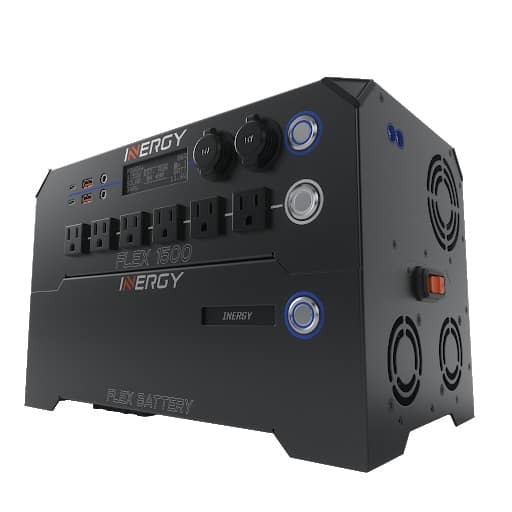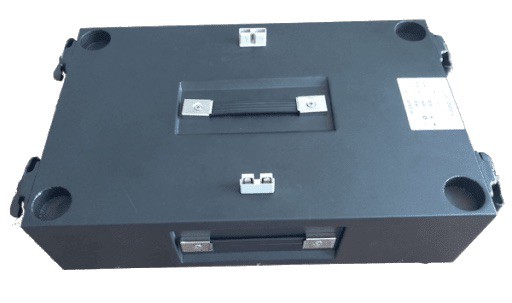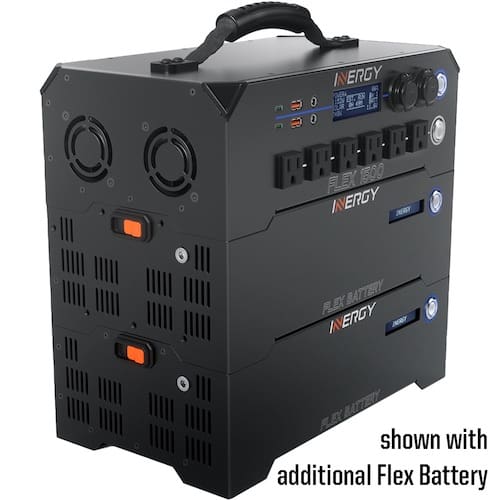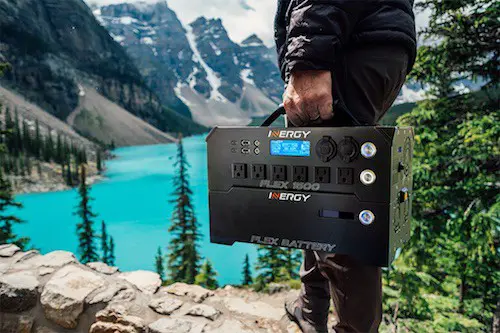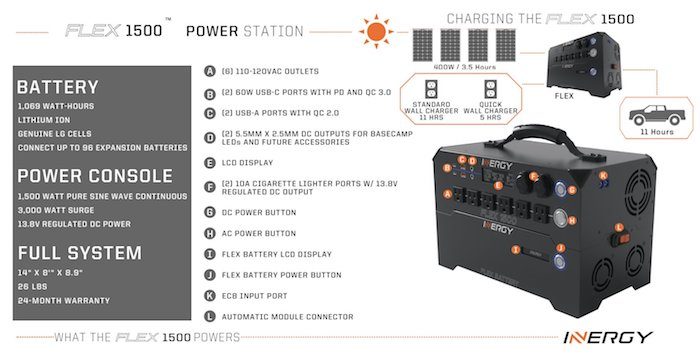Without argument, solar generators are one of the best things to happen since the discovery of secondary energy sources.
They are sophisticated, alternative power sources for machines, power grids, and other appliances.
These great inventions provide exceptional backup power for activities beyond the house like RVs, camping trips, or boating and are best for many reasons.
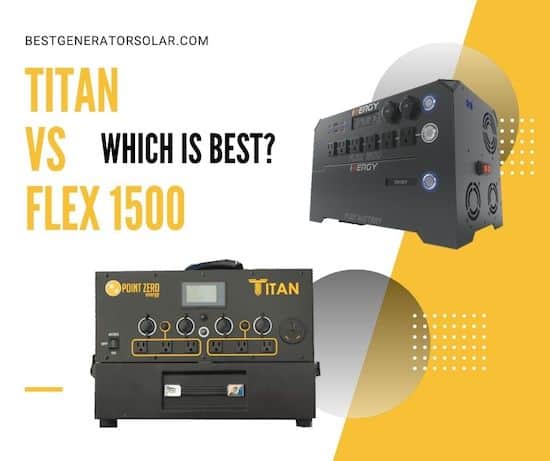
Attached to solar generators are panels that enable them to harness the sun’s energy and store it in batteries for later use.
We rely on a constant supply of power to run our machines, appliances, production factories, and power grids.
Because we rely on the efficient and continuous supply of power, there is a great need to make lasting and efficient power solutions for our homes, businesses, and RV trips.
There is a long list of options available today when it comes to solar generators.
While we might be eager to try one of these options, it can be a frustrating experience if it doesn’t live up to the hype.
Each product varies in efficiency and design; therefore, you should seek all the information available on each solar generator before settling on one.
Proper research will provide you with all the crucial facts you need to help you make an excellent choice.
This article compares two of the best solar generators – The Point Zero Energy Titan and the Inergy Flex 1500 Portable Solar Generator.
This review covers the features that make each product unique and proceeds to recommend which is the best of the two, based on the features and functions that stand out.
The best solar generator between the two is the Point Zero Energy Titan. While both products share many similarities, the Titan wins this review because of the versatility it provides and its history of credibility.
This can be summed up in the following points:
- The Titan has a faster charge rate at 1000W compared to the Inergy Flex 1500, which charges at 600W
- The Titan boasts a higher battery capacity of 2,000Wh per battery
- It has a longer battery life at 2,000 cycles compared to the Inergy Flex, which depends on usage (400-2,000 cycles)
While Inergy has had a great share of success in the market first with the Kodiak power station, the Titan quickly gained prominence after Inergy’s Apex generator failed to live up to the hype and has since remained the best large solar generator in the current solar market.
Nonetheless, both the Titan and Flex 1500 boast several interesting features, so it could be difficult to decide which would serve you best. But if you read on, we have provided you with all the details and features you need for both solar generators so you can make the best choice.
Titan vs Flex 1500 – Specs
| Model: | Titan | Flex |
|---|---|---|
| Brand: | Point Zero Energy | Inergy |
| Image: | 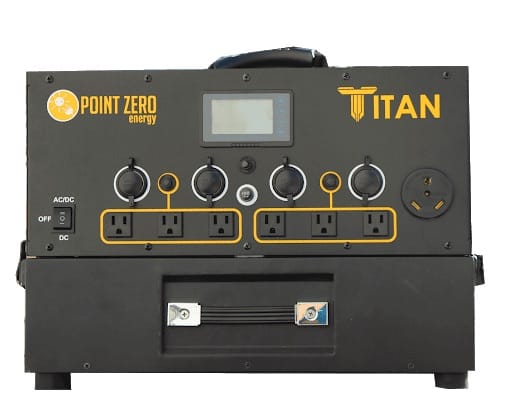 | 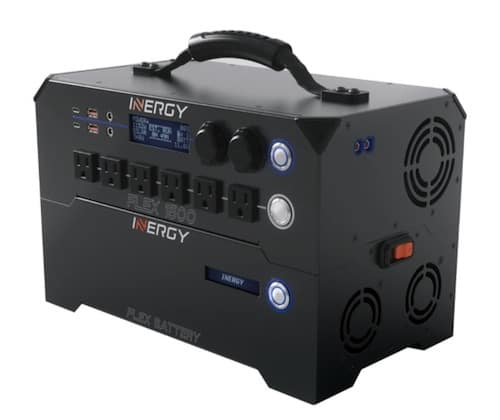 |
| Capacity: | 2,000Wh+ | 1,069Wh+ |
| Expandable? | Y | Y |
| Output: | 3,000W Continuous, 6,000W Surge | 1,500W Continuous, 3,000W Surge |
| Battery Lifecycles*: | 2,000 to unlisted capacity | 2,000 to unlisted capacity |
| Weight: | 68 lbs* | 30 lbs* |
| Battery Type: | Lithium-ion | Lithium-ion |
| Dimensions: | 18.5 x 12 x 12 in* | 14 x 8 x 9.4 in* |
| Where to Buy: | shopsolarkits.com | inergytek.com |
*Battery Lifecycles – The given cycles are the maximum cycles listed for each model. If you intend to use the generator heavily many times over and/or don’t charge it correctly and/or don’t store it properly, this could decrease the cycles drastically or minimally depending on how often the above conditions are met.
With these statistics, you’ll see vast differences in battery capacity, inverter output, and weight to name a few. Read on to find out more details about each generator, starting with the Titan.
Related: Top 3 Most Powerful Solar Generators (Overview + Analysis)
Point Zero Energy Titan Solar Generator- Review
Undoubtedly, the Titan is by far the most durable and versatile solar generator in today’s market. As the name suggests, the Titan boasts of superior components, design, and quality hardware.
With expandable lithium batteries that can clock in 2,000 watts from solar panels, the Titan provides a dependable solar alternative that can power almost any piece of equipment or appliance.
The Titan is a popular choice among many solar users, in part because of the enormous and lasting amount of power it can supply. The Titan can effortlessly power refrigerators, TVs, washing machines, phones, tablets, etc.
Key Features of the Titan
The Titan is by far the most adaptable portable solar generator you can find. Constructed with the best solar technology and quality components, the Titan is a beast of a device that delivers dependable solar backup for any situation. Below are some of the key qualities that make it stand out:
- A detachable and expandable Lithium-ion battery
- 2,000 watt-hour Lithium-ion battery
- 3,000W continuous, 6000W surge high productivity inverter
- Double MPPT charge controllers with an extensive power input range of 2,000 watts in total
Inergy Flex 1500 Generator – Review
The Inergy Flex 1500 is a comparably new product in the solar generator market, having just launched in May 2020. However, Inergy as a company has established its dominance with solar generators such as the Kodiak and Apex in recent years. The Inergy Flex 1500 is a rugged energy monster that features a 1,500 watts uninterrupted (3,000 watts surge) pure sine wave inverter with a compressed, slender design.
With an adaptive and compact exterior, the Flex 1500 runs on a sleek technology that allows convenience in handling, accumulating, and reloading clean energy at any period in time. It even allows multiple connections of Flex batteries while still having the same plug and play value at any point in time.
Inergy Flex 1500 Key Features
The Inergy Flex 1500 console combines technical ingenuity with a compact design, including a 1,500W continuous pure sine wave inverter and 13.8V of measured DC power. This makes it easy to power loads of 110-120V AC and 12V equipment and systems anytime you want to. Here are some of the key features that distinguish the Inergy Flex 1500:
- 1,069 watt-hour nominal Lithium-ion battery
- 1,500W pure sine wave continuous AC Inverter with a 3,000W surge capacity
- Up to 96 Expandable Flex Lithium-ion batteries can be added to the power module
- 14-90V DC solar input MPPT charge controller
The Inergy Flex is the successor to the Apex power station. If you’d like to see the improved features that the Flex has to offer compared to the Apex, check out my article comparing the two systems here: Inergy Apex vs Flex – Inergy’s Premier Solar Generators.
Comparison – Titan vs Flex 1500
As mentioned earlier, the Titan and the Flex 1500 have a lot of similarities. They are, by many standards, the two best solar generators in today’s market. The only models that come close to these two are Goal Zero’s YETI 3000X and 6000X, and they still don’t compare in terms of efficiency and design, but that’s a discussion for another day.
While Inergy and Point Zero Energy have both gained prominence as the best secondary energy solution providers over the years, the Inergy Flex 1500 is still very recent. Its efficiency and durability are still unattested, compared to the Titan, whose success over the years is due to credibility and positive reviews.
Undeniably, Inergy enjoyed massive applause when they launched the Kodiak, but their expectations on the Apex were short-lived when it didn’t live up to expectations. This is why the Titan is still considered the best solar generator, though the new Inergy Flex 1500 features notable improvements in design and efficiency.
Point Zero Energy Titan vs. Inergy Flex 1500 – Comparing Specs and Features
Have you ever wondered what happens if the lights suddenly go out? If all of the important appliances go off, the food starts to defrost and to top it off, you can’t seem to find any light to reach the closest power source?
While it is extremely unlikely that this would happen, situations like this are only one of the reasons we have come to depend on – an uninterrupted power supply.
For this reason, it has become almost imperative that we have more efficient and stable power solutions. Solar generators have not only provided safe alternatives for unexpected power situations but are also used as primary sources of power for activities outside our homes, workplaces, and factories.
Are you looking to buy a solar generator, and you are not sure what features or qualities to look for? The following key features are important to consider when purchasing a solar generator.
Battery Capacity
The capability of a system battery is perhaps the most essential quality to consider when acquiring a solar generator. How long it takes for your system to power appliances or other systems before it requires a recharge depends on the battery’s capacity. Typically, a larger battery capacity controls how long it recharges other devices before it goes off. Sometimes, it also determines how long it takes to recharge.
It is very easy to confuse the ‘1500’ on the Flex 1500 as the capacity of the battery, but it refers to the size of the inverter in this case. The Inergy Flex 1500 takes a 1,069 Wh 12V Lithium battery, which, by contemporary standards, is comparably low. Currently, most companies attempt to go over the 1,000Wh benchmark for larger solar generators, which makes the market more competitive.
On the other hand, the Titan runs at a full-throttle with a 2,000Wh lithium-ion battery, and it has been confirmed to run at the specified battery capacity. Though both come with detachable batteries, that’s a feature the Titan has always had. Regarding the battery capacity, it is safe to say the Titan provides twice the capacity of the Flex 1500.
Opinion: Due to certain unmeasurable inadequacies during the conversion of power from solar to AC power, batteries tend to undergo a reduction in energy supply. Users experienced this with the Apex, and I can’t say they won’t have the same problem with Flex 1500. Time will only tell if this will happen with Flex users. I am optimistic that Inergy has corrected this problem with their new models.
Expandability
I would not advise purchasing a solar generator that does not allow for extra batteries to be added, but that decision is based entirely on needs and budget. However, going for a solar generator that has expandable batteries is worth every penny.
The Point Zero Energy Titan has always been esteemed for its detachable and expandable batteries to decrease or extend capacity. I must say, I am not very surprised that Inergy imitated this feature with the Flex 1500 as it also allows for more batteries to be added. Perhaps subsequent products will keep this feature or improve upon it.
Opinion: Expanding batteries improves the overall efficiency of solar generators by providing more power for usage. Having to add more batteries might mean extra costs, but I do not mind if I am getting a good value for the money I am paying.
Similar: How Long Does a Solar Generator Last? (With Examples)
Weight and Portability
Another important feature to consider when looking to buy a solar generator is the weight and portability. Just how movable is the solar generator? Although this feature may not matter much if you plan to put it in a cabin far away from your house because you would only have to set it up once, you might want to consider a lighter system if you intend to use it for camping purposes, trips, and the likes.
The Titan has an overall weight of 66 pounds (31 lb power module and 35 lb battery). That’s pretty heavy if you intend to use it for outdoor purposes and have to move it around. However, the weight and size are not without an intended purpose in this case, as it has a high battery capacity.
The Flex 1500, on the other hand, weighs 30 pounds at most (14 lb power module and 16 lb battery). That’s very light compared to the Titan and is great for RVs, camping, and trips away from the house. One other cool thing about the Flex 1500 is that you don’t need to regulate the voltage from the batteries before joining them together.
The Titan might need some adjustment since the batteries have to be at close range to regulate proper voltage, but you only need to do that once if your batteries are always together.
Opinion: The Inergy Flex 1500 is comparably lighter. The Titan has twice the weight of the Flex 1500 and occupies more space, but it makes up for this in the efficiency and capacity of the batteries. If you don’t plan to move your device around very often, the Titan is the preferable choice here.
Charge Speed
You may not understand just how frustrating it is when you have to wait 12-18 hours for your system to recharge. The ability to charge quickly is one of the things that makes a solar generator efficient. You want to buy a system that fully recharges within 5-6 hours.
The Titan charges at a speed of 1,000W. This is pretty remarkable considering its size. The speed can be increased by another 1,000W if you add an extra battery. The Titan has a reputation for clocking the specified numbers, so if they say it charges at 1,000W, it really does.
The Inergy Flex 1500 is said to handle 600W of solar input on a single battery and can take up to 2,000W if a second battery is added. This means it could recharge your battery in about 2 hours. That’s also pretty fast!
Something to note, however, is that Inergy made quite a reputation with the Kodiak and Apex. While boasting the same charge speed, many people ended up frying their Kodiak generators in a bid to get it to clock 600W. The Apex featured EC8 plugs to ensure safe charging, which helped to solve this issue.
Opinion: The Flex 1500 has cool features with the MPPT Superchargers that allow you to charge up to 1,200W, though that will incur an added cost. The Titan does not require any add on, and you still get a maximum input of 2,000W; it also features dual MPPT charge controllers. So, the Titan wins it for me because of its consistency and reputation for clocking the specified charge speed.
Battery Life Cycles/Durability
There was a time solar generators used lead-acid batteries. This had a backward effect on batteries as they seemed to wear out after several uses. Imagine buying a solar generator whose batteries wear out! But since then, improvements have been made with the introduction of Lithium-ion batteries.
This means you can rely on a longer overall battery life with Lithium-ion batteries.
The Flex 1500 does not take a clear stand on this. It is only stipulated in the FAQs as being dependent on usage. That doesn’t sit right with someone like me because although the usage factor is important and true for all lithium solar generators, Inergy stated that the Flex will run anywhere from 400-2,000 cycles, which allows for a huge question mark when considering what I can and cannot power.
That means I can only get between 400-2,000 cycles within the period of, say seven years before I need another battery. That may seem fair, but if you aren’t planning on spending hundreds of dollars on another battery in a couple of years, you might want to think carefully before giving this a go.
On the other hand, the Titan retains some percentage of its battery capacity. You don’t completely exhaust power on the batteries, and you still get about 2,000 cycles on each battery. That’s an equivalent of 10 years, even on heavy usage.
Opinion: The Titan easily wins it here for me again. But overall for all solar generators, it’s a smart move to restrict consistent heavy usage, so you don’t completely drain the batteries and potentially jeopardize the overall capacity and efficiency.
Similar: Portable Solar Panels: Advantages and Disadvantages
Number of Ports and RV Outlets
Only very few solar generators from recent years feature significant numbers of ports and RV outlets. Multiple ports make it easy for a solar generator that has the feature to optimize power when running powerful gadgets and systems simultaneously.
Both the Titan and Flex 1500 feature numerous outlets and ports. Both have six 110/120V wall outlet plugs. The Titan also features 4 DC ports and allows you to switch between AC power and DC power. The quad DC port feature allows you to choose between DC power and converter with the USB charge plugs, with enough spaces between the plugs.
The Inergy Flex 1500 also has six 110/120V wall outlet plugs, but it features two DC ports and four USB ports of types A and C. It is also different from the Titan in that it uses an entirely different power station for DC power alone. This model is the Flex DC unit.
Titan Port Diagram
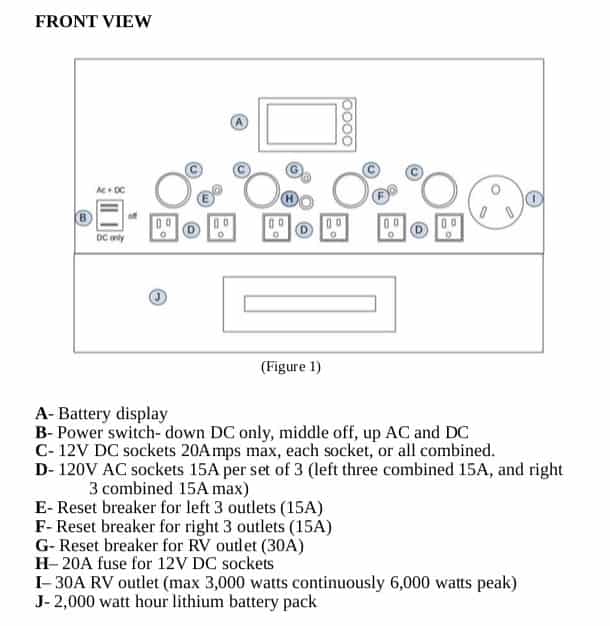
Flex 1500 AC Port Diagram
Opinion: I like that Inergy decided to be more competitive by introducing several outlet features for its Flex 1500 and Flex DC models. Though some people may prefer the simple and extensive amount of outlets that the Titan offers, I like the idea of using an entirely separate power station. The Inergy Flex models win it here for me.
Inverter Size
The Flex 1500, as the name suggests, features a 1,500W continuous pure sine wave inverter. That’s quite a feature for a system that’s lightweight. However, the size of the inverter determines the level of power you get from the battery. I think the Flex 1500 risks its capacity with this feature if you intend to use it with large appliances with only one battery.
The Titan, however, is twice the size of the Flex 1500 inverter. It has a 3,000W continuous pure sine wave inverter and a surge of 6,000W at full capacity. It has been tested to run at 3,000W continuously from 100-0%. That’s crazy power! You can run nearly any kind of equipment you’d like with the Titan.
Opinion: I would rather have a device that does its work perfectly than one which doesn’t and makes up for it in portability. It still depends on what you want to use the battery for and if it’s going to be mobile. You may have a difficult time moving the Titan about – though you get power at full capacity, whereas the Flex makes moving quite easy but is limited in capacity. If you add an additional battery to the Flex, that’s another 16 lbs added to the system, which would make portability difficult.
Warranty and Customer Support
The quality of customer service is determined by the promptness of response and accuracy in problem resolution. It is pointless to buy a product if you can’t get a quick response from the company or get a problem solved when one arises.
The Titan has a great customer service reputation. They have a history of receiving positive feedback and reviews from their customers. Point Zero Energy offers a two-year warranty on the Titan and 1-year warranty on the lithium-ion batteries.
This is an area Inergy has to work and improve upon. Proper research on reviews will show you they do not have a great way with customers, though I believe improvements must have been made upon the introduction of the Flex 1500. However, they offer a two-year warranty on the Flex 1500 and up to a 10-year warranty on their batteries, if purchased at the pre-sale price.
Opinion: You can easily read reviews for both on Amazon and find out the experiences others have with the product. You will be easily convinced which is best and why. Make sure to read in-depth reviews on Amazon, as generic and short reviews tend to be either misleading or not useful when deciding for yourself which product receives better customer service reviews.
Pricing
Currently, on shopsolarkits.com (and several other retailer websites), the Titan costs $2,995, and you might get a discount depending on holidays and terms, while the Flex costs $1,500 at MSRP.
You can tweak the Flex to match the Titan in capacity by adding an extra battery and the MPPT Supercharger, though you would have to part with nearly $1,500 more dollars in the range of $2,950 to make this happen. Remember, I mentioned earlier that the Titan weighs twice the size of the Flex and is much more improved in terms of capacity. If you were to add the MPPT Supercharger and additional battery to the Flex, it would weigh approximately 58 lbs.
However, if you add another battery to the Titan, what you get is a battery capacity of 4,000Wh for about $4,400. If you are to get the same capacity on the Flex, you would have to spend at least $4,850 at MSRP on the Flex, three additional batteries, and one MPPT Supercharger.
Final Thoughts
Although the Titan and the Flex 1500 share many similar features, I would recommend the Titan because it beats the Flex in a few crucial categories and because Point Zero Energy has built an outstanding reputation with the Titan. After numerous tests, the Titan proved to have lived up to the hype. They say it actually does what the makers say it does, which is the number one factor to seek out when researching solar generators.
Personally, I would prefer to buy a product with a better history of performance than a new product with slightly more advanced features for obvious reasons. The Titan has a better history of living up to expectations, and you can rest assured you will be getting the value for your money.
When Inergy first came up with the Kodiak, it quickly gained popularity because of its amazing features and actual capacity, and a lot of users were on the lookout for Inergy’s next great product. After a short wait, the Apex came with quite a lot of buzz, and a lot of buyers were quick to leap at the latest product from Inergy. But their expectations were soon short-lived when Apex didn’t perform as well as expected.
I do not doubt that the Titan and the Flex 1500 are perhaps the best solar generators out there to date, but when it comes down to these two, I will pick the Titan every time. I have heard good things about the Flex 1500, and I think it has plenty of amazing features, but I would not be so quick to recommend it for the reasons mentioned previously. If what you are looking for is the best solar generator that will serve all your needs, the Titan is the way to go.
Read more detailed information and specifications of the Titan solar generator from my review of the system here: Titan Solar Generator Review – The Best Large Solar Generator?
If you want to navigate the various packages/kits offered for the Titan, click the button below to shopsolarkits.com (I am affiliated with this company and make a small commission for every sale with the link provided).
Continue Reading:

